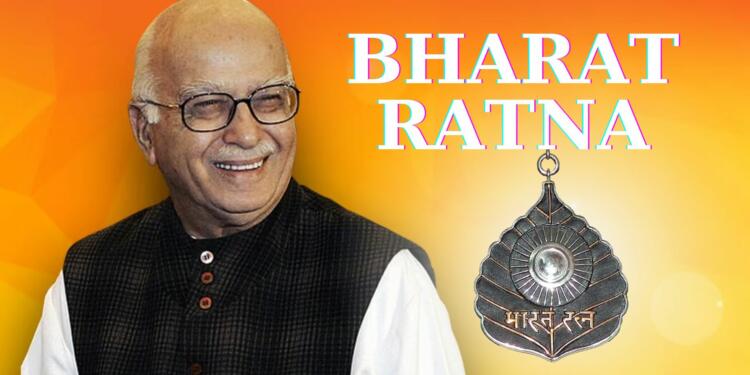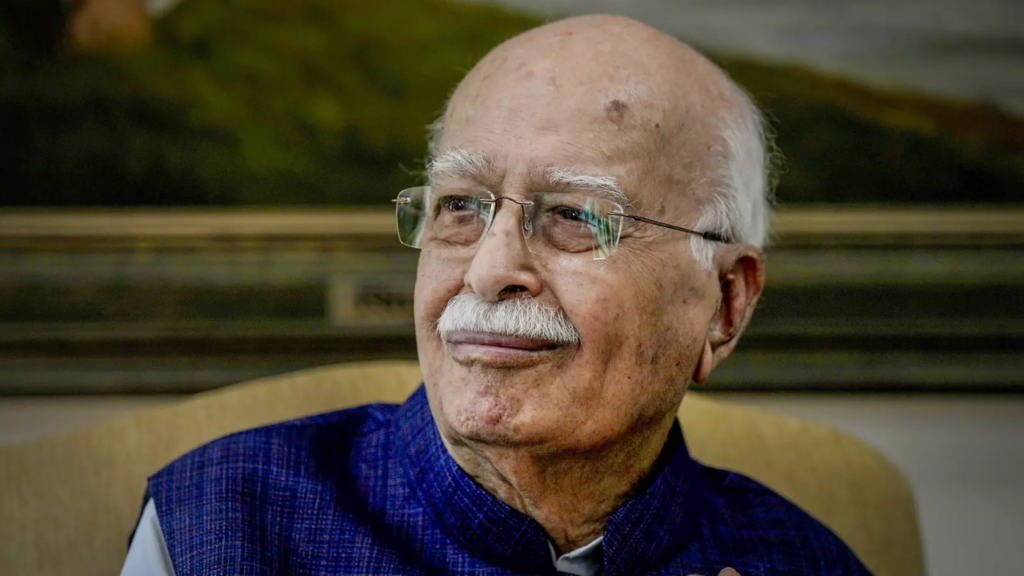
The Rath Yatra, organized by Advani, brought great success to the Bharatiya Janata Party (BJP), leading to significant wins in later elections.
Lal Krishna Advani, a veteran BJP politician, has been honored with the Bharat Ratna, the country’s highest civilian award. He joins a list of right-wing leaders and intellectuals, including Madan Mohan Malviya, Nanaji Deshmukh, and Atal Bihari Vajpayee, who have also received this award from the Modi government.
The Bharat Ratna ceremony coincides with the inauguration of the Ram Temple in Ayodhya, built on the site of the demolished Babri Masjid. The mosque was torn down by Karsewaks, a group of militant Hindu nationalists organized by the BJP-RSS and allied groups to build the Ram Temple.
This moment prompts us to reflect on the extraordinary service of Lal Krishna Advani, which merits his Bharat Ratna recognition. We revisit his political legacy and contributions to Indian politics, particularly during the era of aggressive Hindutva posturing in the 1990s, spearheaded by Advani through the Rath Yatra. Although now retired from active political life, Advani remains an early proponent of aggressive right-wing Hindutva politics in India, significantly influencing the political discourse. He is a founding member of the BJP.

Table of Contents
Toggle“The Unapologetic Leader: Exploring Militant Hindutva Politics”
The Ram Janmabhoomi Movement marked a significant shift in Indian politics, bringing the ideology of Hindutva into the mainstream.
During this time, Hindutva politics became more militant, with groups like Bajrang Dal and Vishwa Hindu Parishad playing a key role in inciting communal violence and polarizing the electorate.
The movement aimed to revive right-wing Hindutva politics and consolidate Hindu votes by capitalizing on religious sentiments.
It countered the impact of Mandal democratization and sought to create a Hindu vote bank by co-opting non-dominant castes and fostering animosity towards minorities, particularly Muslims.
Advani, a prominent figure in Hindutva politics, used the Ram Janmabhoomi Yatra to rally Hindus and oppose Mandal politics, which he believed divided Hindus.
The Yatra aimed to unite Hindus spiritually and counter subaltern political assertions.
Aloso Read | Elevate Your Gaming Experience: Key Considerations When Purchasing a Gaming Monitor

The Political Spirituality of the Rath Yatra”
The Rath Yatra procession aimed to awaken political consciousness among Hindus, uniting them in anger against perceived attacks on their religious and cultural identity, even after independence under pseudo-secularism. Gyanendra Pandey explains that the Babri Masjid conflict in Ayodhya was part of a broader Hindu effort to reclaim national culture from perceived adversaries, including Muslims, secularists, and Westerners.
The Toyota Van, designed like a chariot, prominently featured Advani’s portrait and slogans supporting the Ram Mandir movement. Richard Davis notes that the Babri Masjid site juxtaposes two figures well-known in North India: Ram and Babar, representing Hinduism and Islam, respectively, but with a significant imbalance in portrayal.
The movement aimed to incite communal fervor and establish Ayodhya as a sacred national center, projecting Ram Janmabhoomi as a national issue requiring liberation from perceived historical wrongs inflicted by Muslims. Advani’s 35-day Yatra covered approximately 10,000 km, passing through eight North Indian states known as Sangh strongholds. Starting from the Somnath temple, which held symbolic importance for Hindutva, Advani viewed the reconstruction of Somnath as the first step in preserving symbols of unity and communal harmony, followed by the Ram.
Congratulations to Shri #LKAdvani Ji on being awarded the nation's highest civilian honour, the #BharatRatna. Advani Ji has distinguished himself through exemplary hard work and devotion towards the nation. A scholar and statesman, he has made exceptional contributions to the… pic.twitter.com/FSEsvxXm0F
— N Chandrababu Naidu (@ncbn) February 3, 2024
What role did the Rath Yatra play in the success of the Bharatiya Janata Party (BJP)?
- The Rath Yatra, organized by Advani, significantly contributed to the BJP’s success, leading to significant wins in later elections.
Who is Lal Krishna Advani, and why was he honored with the Bharat Ratna award?
- Lal Krishna Advani is a veteran BJP politician honored with the Bharat Ratna for his exceptional service to the nation.
What significant event coincided with the Bharat Ratna ceremony for Lal Krishna Advani?
- The Bharat Ratna ceremony coincided with the inauguration of the Ram Temple in Ayodhya, built on the site of the demolished Babri Masjid.
What prompted the reflection on Lal Krishna Advani’s service and contributions?
- The Bharat Ratna award prompted a reflection on Advani’s extraordinary service and contributions to Indian politics.
What was the aim of the Ram Janmabhoomi Movement in Indian politics?
- The Ram Janmabhoomi Movement aimed to bring the ideology of Hindutva into the mainstream of Indian politics.
How did the Rath Yatra contribute to the polarization of Indian politics?
- The Rath Yatra aimed to awaken political consciousness among Hindus and unite them against perceived attacks on their religious and cultural identity.
What symbols and slogans were prominent during the Rath Yatra organized by Advani?
- The Toyota Van used in the Rath Yatra featured Advani’s portrait and slogans supporting the Ram Mandir movement.
What historical figures were juxtaposed at the Babri Masjid site according to Richard Davis?
- Richard Davis noted that the Babri Masjid site juxtaposed two figures: Ram and Babar, representing Hinduism and Islam, respectively.
What was the geographical coverage of Advani’s Rath Yatra?
- Advani’s Rath Yatra covered approximately 10,000 km, passing through eight North Indian states known as Sangh strongholds.
What symbolic significance did the Somnath temple hold in the Hindutva narrative during the Rath Yatra?
- The Somnath temple held symbolic importance in the Hindutva narrative as the first step in preserving symbols of unity and communal harmony, followed by the Ram.


